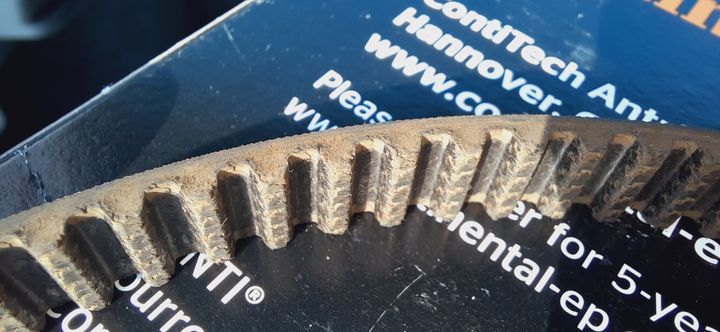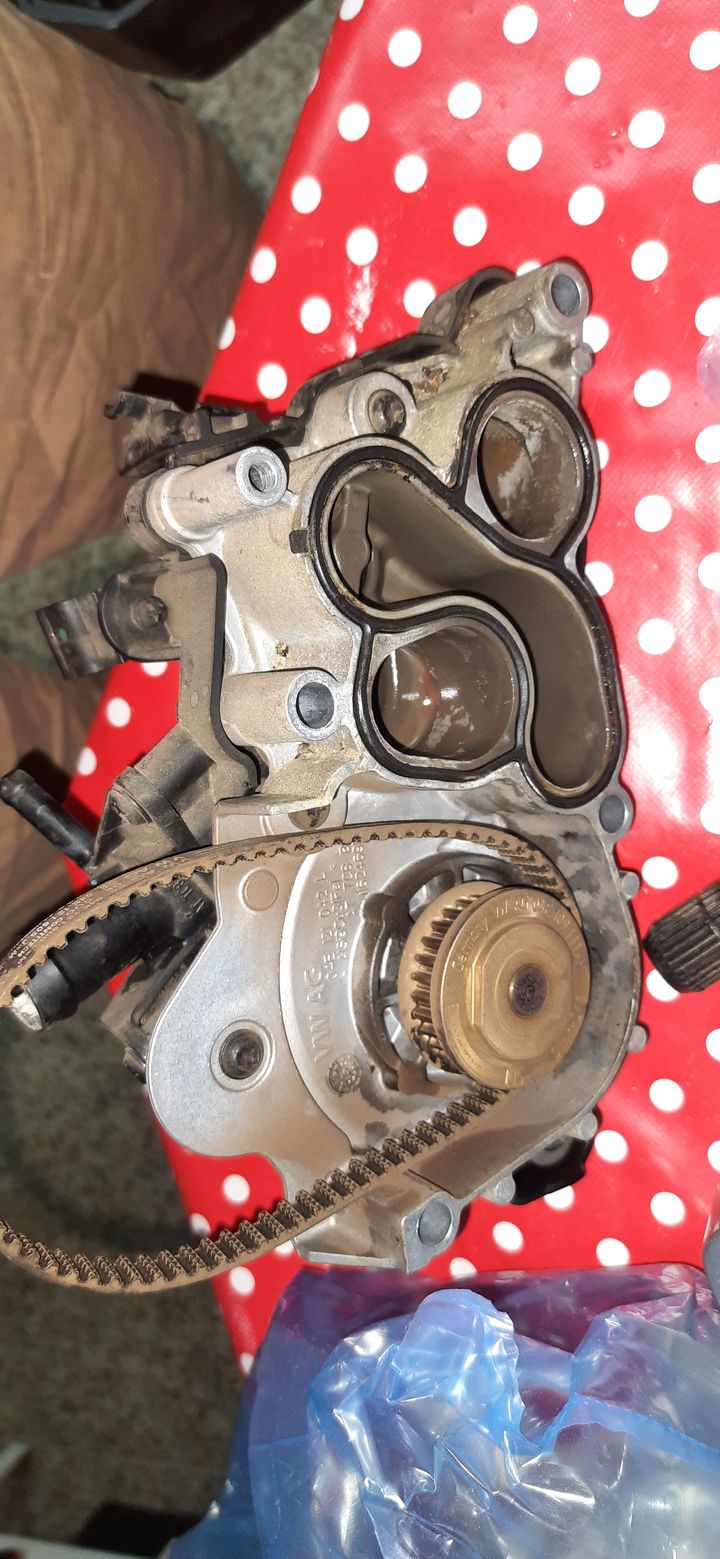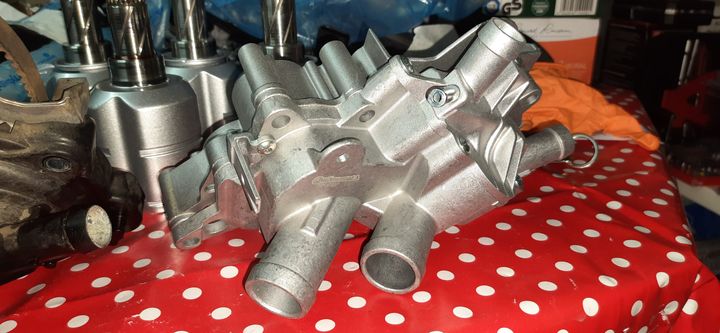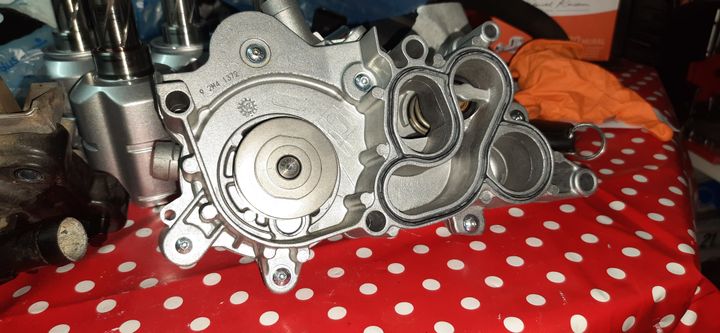1.2TSI water pump replacement
Discussion
Hello everyone,
I recently replaced the water (coolant) pump on my 1.2TSI CJZC engine, on a Seat Toledo KG3 MY2016, and I wanted to share the experience. This also applies to VW/Audi/Skoda/Seat engines of the EA211 family (1.2/1.4TSI), the previous version (EA111) is a completely different engine.
Background:
The original pump fitted on the car since new worked perfectly well (no leaks, no overheating), this replacement was purely preventive given the car had 393.000km (244.00mi) and almost 10 years. The pump is driven by a tiny toothed belt driven by the exhaust camshaft on the gearbox-side of the engine, and belts inevitavely wear over time, and a failure of this belt will basically destroy the engine in a matter of minutes. Note the car manual does NOT state any change interval on this belt or the pump.
Tools and materials required:
- Set of hose clamp pliers in various sizes and forms. Normal pliers will not do the job in several places.
- Vaccum coolant filler. I can't stress enough how essential this tool is Without this you may ruin your engine. They are relatively cheap and easy to get, and they work well.
- Set of 1/4" wrench including several extension. Some bolts are tricky to get.
- Workshop manual. A certain procedure must be followed (belt tensioning and bolt tightening order).
- A helper is needed in several steps, so avoid doing this job alone.
- Spare pump and belt. There are several brands with different combinations, given the "pump unit" comprises the actual pump, two thermostats and a housing. My reccomendation is to replace the whole set, and one manufacturer offers a complete pump alredy fitted with the thermostats and a aluminium housing (OEM is plastic), which is the one I used.
Tips and learnings:
- This job can be done independently of the timing belt replacement. However, some of the parts that have to be removed (intake pipes basically) are the same, so you may save some time if you do both jobs at once, but note that difficuty accumulates. Some workshops reccomend to do both because other engines drive the pump with the timing belt, but not here, so if the pump is not leaking I would just replace the timing belt every 210.000km as recommended.
- If you are a DIY mechanic, allow for 5-7h for the pump replacement,
- Don't attempt this job on a cold engine, many plastic parts have to be removed and they break more easily if they are cold. On the other hand, don't do it on a hot engine, since you can get scalded with hot coolant.
- The belt was in relatively good shape even after so many km and years so, again, this seems to last more than expected (almost 400.000km!).
- Although the manual does not mention it, the turbo intake pipe ( 04E129656S), which is a weird shaped plastic elbow MUST be removed, and it is tricky to do so: one bolt requires a right extension and the other one is only accesible from under the car.
- A floor jack/lift will be needed for some steps, basically draining the coolant and accessing that bolt on the intake pipe elbow.
- The coolant circuit (actually circuits)on this engine is very complex and DOES NOT PURGE/BLEED by itself. Don't attempt to fill the reservoir, start the engine with the cap removed and wait for the circuit to bleed itself, as it will not do it. Asides from this, one thermostat opens at 103-105ºC, so it may boil the coolant if the cap is left open. Don't do this.
- Use a vaccum filler, not only because the manual recommends it but also because it works very well and it is very clean to use. Just pull a decent vacuum (-0,5/-0,6bar) and let the coolant go in. You can repeat the process until no air pockets remain in the system.
- If the circuit is not properly bled/purged, the engine will overheat and will be damaged. If after filling th circuit you see the coolant temperature exceed 90ºC, then you have an airlock and you need to stop the engine inmediately.
- Thoroughly clean the flat surface of the cylinder head where the pump gasket seats. A scotch-brite is needed since some "burnt" rubber of the gasket remains on the surface. Be careful not to put debris from the scotch-brite in the cylinder head cavities.
- There is no need to replace the o-rings in the intake pipes, the original ones are good-quality green viton/FKM and the were like new.
Attached you will find some pictures of the old and the new pump.






I hope this will help someone out there.
Cheers
I recently replaced the water (coolant) pump on my 1.2TSI CJZC engine, on a Seat Toledo KG3 MY2016, and I wanted to share the experience. This also applies to VW/Audi/Skoda/Seat engines of the EA211 family (1.2/1.4TSI), the previous version (EA111) is a completely different engine.
Background:
The original pump fitted on the car since new worked perfectly well (no leaks, no overheating), this replacement was purely preventive given the car had 393.000km (244.00mi) and almost 10 years. The pump is driven by a tiny toothed belt driven by the exhaust camshaft on the gearbox-side of the engine, and belts inevitavely wear over time, and a failure of this belt will basically destroy the engine in a matter of minutes. Note the car manual does NOT state any change interval on this belt or the pump.
Tools and materials required:
- Set of hose clamp pliers in various sizes and forms. Normal pliers will not do the job in several places.
- Vaccum coolant filler. I can't stress enough how essential this tool is Without this you may ruin your engine. They are relatively cheap and easy to get, and they work well.
- Set of 1/4" wrench including several extension. Some bolts are tricky to get.
- Workshop manual. A certain procedure must be followed (belt tensioning and bolt tightening order).
- A helper is needed in several steps, so avoid doing this job alone.
- Spare pump and belt. There are several brands with different combinations, given the "pump unit" comprises the actual pump, two thermostats and a housing. My reccomendation is to replace the whole set, and one manufacturer offers a complete pump alredy fitted with the thermostats and a aluminium housing (OEM is plastic), which is the one I used.
Tips and learnings:
- This job can be done independently of the timing belt replacement. However, some of the parts that have to be removed (intake pipes basically) are the same, so you may save some time if you do both jobs at once, but note that difficuty accumulates. Some workshops reccomend to do both because other engines drive the pump with the timing belt, but not here, so if the pump is not leaking I would just replace the timing belt every 210.000km as recommended.
- If you are a DIY mechanic, allow for 5-7h for the pump replacement,
- Don't attempt this job on a cold engine, many plastic parts have to be removed and they break more easily if they are cold. On the other hand, don't do it on a hot engine, since you can get scalded with hot coolant.
- The belt was in relatively good shape even after so many km and years so, again, this seems to last more than expected (almost 400.000km!).
- Although the manual does not mention it, the turbo intake pipe ( 04E129656S), which is a weird shaped plastic elbow MUST be removed, and it is tricky to do so: one bolt requires a right extension and the other one is only accesible from under the car.
- A floor jack/lift will be needed for some steps, basically draining the coolant and accessing that bolt on the intake pipe elbow.
- The coolant circuit (actually circuits)on this engine is very complex and DOES NOT PURGE/BLEED by itself. Don't attempt to fill the reservoir, start the engine with the cap removed and wait for the circuit to bleed itself, as it will not do it. Asides from this, one thermostat opens at 103-105ºC, so it may boil the coolant if the cap is left open. Don't do this.
- Use a vaccum filler, not only because the manual recommends it but also because it works very well and it is very clean to use. Just pull a decent vacuum (-0,5/-0,6bar) and let the coolant go in. You can repeat the process until no air pockets remain in the system.
- If the circuit is not properly bled/purged, the engine will overheat and will be damaged. If after filling th circuit you see the coolant temperature exceed 90ºC, then you have an airlock and you need to stop the engine inmediately.
- Thoroughly clean the flat surface of the cylinder head where the pump gasket seats. A scotch-brite is needed since some "burnt" rubber of the gasket remains on the surface. Be careful not to put debris from the scotch-brite in the cylinder head cavities.
- There is no need to replace the o-rings in the intake pipes, the original ones are good-quality green viton/FKM and the were like new.
Attached you will find some pictures of the old and the new pump.
I hope this will help someone out there.
Cheers
Gassing Station | Engines & Drivetrain | Top of Page | What's New | My Stuff



